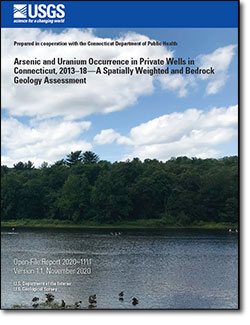Pennsylvania Water Science Center
Home
Coronavirus (COVID-19) Update
We are operating at maximum telework and continue to conduct the important work of the USGS, including maintaining mission essential and critical functions. We have implemented new safety and fieldwork processes to maintain social distancing to ensure the safety of our employees and communities while following all guidance from the White House, Department of the Interior, USGS, Centers for Disease Control and Prevention (CDC), and Pennsylvania state and local authorities.
Follow coronavirus.gov for the latest COVID-19 information from the federal government
News
USGS and Pennsylvania Department of Agriculture study groundwater quality in agricultural areas
USGS Pennsylvania Water Science Center and the Pennsylvania Department of Agriculture have agreed on a new five-year program to continue 30 years of cooperation assessing groundwater quality in agricultural areas.
USGS has two openings for recent-graduate water scientists in Pennsylvania
The Pennsylvania Water Science Center is looking for two recent graduates, one focused on groundwater and one on water quality, to join our team. These are Term Pathways...
Pennsylvania Waters - Winter 2020 - Issue 3
News in this issue of Pennsylvania Waters includes a visual story about water availability and quality in the Delaware River Basin, StreamStats updates for Pennsylvania, a water-quality modeling tool for acid mine drainage treatment systems, a national water dashboard for flooding and other stream data, studies of nutrients and sediments in the Chesapeake Bay watershed, and more!
Publications
Arsenic and uranium occurrence in private wells in Connecticut, 2013–18—A spatially weighted and bedrock geology assessment
The U.S. Geological Survey, in cooperation with the Connecticut Department of Public Health, conducted a study to determine the presence of arsenic and uranium in private drinking water wells in Connecticut. Samples were collected during 2013–18 from wells completed in 115 geologic units, with 2,433 samples analyzed for arsenic and 2,191 samples...
Gross, Eliza L.; Brown, Craig J.Meeting the challenge: U.S. Geological Survey North Atlantic and Appalachian Region fiscal year 2020 in review
The utilization, preservation, and conservation of the Nation’s resources requires well-informed management decisions. The North Atlantic and Appalachian Region (NAAR) of the U.S. Geological Survey (USGS) supports science-based decision making for Federal, State, and local policymakers to meet the challenges of today and into the future. The...
Development of a suite of functional immune assays and initial assessment of their utility in wild smallmouth bass health assessments
Methods were developed for measuring immune function in Micropterus dolomieu (smallmouth bass). The ultimate objective is to monitor and evaluate changes over time in immune status and disease resistance in conjunction with other characteristics of fish health and environmental stressors. To test these methods for utility in ecotoxicological...
Smith, Cheyenne R.; Ottinger, Christopher A.; Walsh, Heather L.; Blazer, Vicki S.






